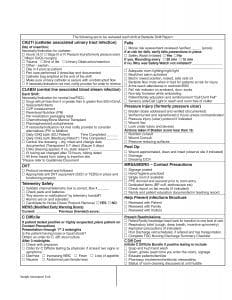A large healthcare system shares its model for success.
Takeaways:
- Traditional bedside shift reporting may not focus on specific patient safety prevention methods.
- An enhanced assessment can include targeted evidence–based actions designed to standardize patient safety into a checklist.
AS OF September 30, 2018, CHSPSC, LLC, and its affiliates and subsidiaries (CHS) had reduced serious safety events by 86% through the use of high-reliability principles. The steps taken to achieve this reduction, including implementing

The journey begins
As of December 31, 2018, CHSPSC, LLC, along with CHS consists of 113 hospitals in 20 states; the organization also includes ambulatory care centers, urgent care centers, and physician clinics. In 2012, CHS developed a component Patient Safety Organization (CHS PSO, LLC – AHRQ, PO122) to improve the safety and quality of patient care and embarked on a journey to achieve zero patient harm events by becoming a high-reliability organization (HRO). By studying the origin of patient safety events and understanding the level of harm they caused, the CHS executive team established safety as one of the organization’s core values. CHS partnered with HPI Press Ganey to deploy proven leadership methods and human-error prevention behaviors.
The PSO staff—along with a patient safety committee composed of nurses, physicians, and other subject matter experts—developed a safety strategy and continues to support affiliated hospitals’ efforts. Hospital leaders practice leadership methods (daily safety huddles, Safety First [making safety the first agenda item in all meetings], and prioritizing top 10 safety issue lists), recruit local physician mentors to educate medical staffs, and implement the safety coach program.
Safety coaches are frontline team members who teach their peers how to use human error prevention tools, such as the S.A.F.E. toolkit. (See Keeping it safe.) At the end of 2018, over 1,200 safety coaches were placed across the organization, with 20,000 recorded safety coach observations that were used to correct and reinforce error-prevention behaviors.
Keeping it safe
The S.A.F.E. toolkit teaches error-prevention behavior. It was developed with HPI Press Ganey based on a reliability safety culture diagnostic assessment of common causes of past events.
- Support the team. We use tools to: Tools are used to leverage the way staff work together, check the accura- cy of team members’ work or tasks, identify slips and lapses, point out unusual hazards, conduct impromptu consultations, and correct unsafe or at-risk behavior.
- Ask questions. When team members practice with a questioning attitude, they know they’re empowered to act when something doesn’t seem right or doesn’t make sense. They verify with an external source or ref- erence before proceeding in the face of uncertainty or when they need to escalate a concern. Issues are ad- dressed using ARCC:
- Ask a question
- Request a change
- Voice a concern
- Engage the chain-of-command if a concern isn’t resolved.
- Focus on task. The chance of human error increases when we’re rushed, distracted, multi-tasking, or fatigued. Using the STAR (Stop-Think-Act-Review) method before performing a safety-critical task gives team members’ brains a chance to catch up with their actions.
- Effective communication every time. Communicating effectively and proactively to eliminate errors in com- munication (such as mistaking words or numbers that sound similar or omitting important information) is the basis for this tool in the toolkit. Staff can reduce the likelihood of information being misunderstood by com- municating with phonetic and numeric clarifiers when words and numbers sound alike. Standardizing handoff communication using SBAR (Situation-Background-Assessment-Recommendation or plan) helps prevent omitting important information during handoffs such as at bedside shift report.
BSR and patient safety
CHS has been using the BSR since 2010. Rather than giving shift report outside the patient’s room, nurses going on and off shift meet at the patient’s bedside to review the care plan and discuss procedure, test, and medication updates. A study by Williams found that the BSR, which is used on many nursing units across the United States, is one of the most important elements of safe patient care.
CHS affiliated hospitals implemented bedside shift report in an SBAR format (Situation, Background, Assessment, Response) and put significant effort into adopting a consistent BSR practice. Initial resistance to the BSR—which included concerns about privacy, confidentiality, and time—was consistent with what the literature reported. A thorough review of a complex patient BSR revealed that it didn’t take more time than shift report outside of the patient’s room; CHS continues to carefully review overtime. These findings were given to chief nursing officers to share with their staff and allay concerns.
The BSR improved the patient experience, but was it keeping patients safe? Could nurses use BSR processes to communicate and assess triggers for preventable, hospital-acquired conditions (HACs) and other potential safety issues?
Patient safety assessment checklist
Reliability science shows that a complex safety-critical work process that’s used by multiple people requires a checklist or job aid to promote consistency. The checklist also can serve as an effective barrier to prevent HACs and other patient harm events.
Through an analysis of our patient safety event and outcomes data, CHS nursing leaders determined that adding an assessment and communication checklist to the BSR would enhance patient safety. The increased focus by all stakeholders on HACs guided the first version of the HAC Addendum checklist. Conditions covered in the assessment included hospital-acquired infections, central line–associated bloodstream infections, catheter-associated urinary tract infections, falls, and pressure injuries. A companion “Guidelines for Use” document was developed to provide further expectations, details, and resources to ensure consistent comprehension and use of the checklist.
Education for using the HAC Addendum was developed with input from a interprofessional group and was placed on the CHS online learning management system, which allows for web-based, self-paced education. Skills labs were recommended for observing the process to ensure that staff were comfortable and could demonstrate competency. In addition, a demonstration video was produced and distributed to nursing staff and used in new graduate nurse orientation.
As the evidence for preventing HACs grew, so did the content of the HAC Addendum. Patient safety issues—safe cardiac telemetry use, care transition measures, family education related to infection prevention, and falls prevention—that emerged nationally or were reported to the organization’s PSO were added to the checklist. As the Addendum grew, CHS acknowledged that it was no longer HAC focused but rather patient safety focused; the name was changed to Patient Safety Assessment. (See Patient Safety Assessment.) Accordingly, the guidelines for use were updated with each version of the assessment.
To hold nurses accountable for practicing BSR with the Patient Safety Assessment, nursing leaders rounded on patients every day to validate that they were involved in and aware of the BSR, that their communication white boards were updated, and that they understood their plan of care, including any medications ordered and administered. These validation rounds are essential to BSR/Patient Safety Assessment effectiveness.
Patient safety assessment


Nurses share their creative use of the tools on month- ly calls among chief nursing officers from the system hospitals. They’ve suggested laminating the Patient Safety Assessment, attaching it to clipboards, and adding it to patient communication white boards. Patients’ perceptions of the BSR/Patient Safety Assessment also are measured. Beginning in the third quarter of 2013, CHS included a Press Ganey custom question for measuring BSR effectiveness by asking patients: “How well did the nurses communicate with you during bedside shift report?” We also study the correlation between a patient’s perception of an effective BSR and Nurse Communication and Overall Rating top box results and have found a strong, positive correlation.
By incorporating patient safety assessments into BSRs, CHS affiliated hospitals achieved a 26.5% reduction in hospital-acquired infections in 2018 compared to 2017.
Content contained in the Patient Safety Assessment is dynamic, and CHS continues to evaluate it for evidence and trends to be added or removed. The HRO process and tools and leadership support have been instrumental in this successful patient safety initiative.
HRO success
The checklist created to accompany the BSR enables a consistent and thorough assessment of patient needs and concerns, helps nurses assess multiple safety and quality triggers, and ensures patients and their families are prepared for care during and after hospitalization. Chief nursing officers and clinical nurses regularly review and evaluate the assessment tool and make revisions as needed, and its effective use is part of the nursing staff competency assessment. Because the deployment of the Patient Safety Assessment tool was so successful, CHS continues to initiate implementation of other clinical tools based on high reliability principles.
The authors work at CHSPSC, LLC. Pam Rudisill is senior vice president and chief nursing officer. Terrie Van Buren is vice president and patient safety officer. Lisa Stefanov is vice president of nursing informatics and survey management.
Selected references
Agency for Healthcare Research and Quality. Patient safety organizations program. March 2018. ahrq.gov/cpi/about/otherwebsites/pso.ahrq.gov/index.html.
Clapper C. Keep it simple: Integrating human factors into guidance documents to drive reliability. Industry Edge. March 2016. pressganey.com/docs/default-source/industry-edge/issue-2/keep-it-simple-integrating-human-factors-into-guidance-documents-to-drive-reliability.pdf?sfvrsn=2
Faloon DN, Hampe H, Cline T. Effects of multimethod intervention on bedside report compliance and patient satisfaction. Crit Care Nurs Q. 2018;(41)2:129-41.
Mardis T, Mardis M, Davis J, et al. Bedside shift-to-shift handoffs: A systematic review of the literature. J Nurs Care Qual. 2016;31(1):54-60.
McAllen ER Jr, Stephens K, Swanson-Biearman B, Kerr K, Whiteman K. Moving shift report to the bedside: An evidence-based quality improvement project. OJIN. 2018 ojin.nursingworld.org/MainMenuCategories/ANAMarketplace/ANAPeriodicals/OJIN/TableofContents/Vol-23-2018/No2-May-2018/Articles-Previous-Topics/Moving-Shift-Report-to-the-Bedside.html
Press Ganey. Insight and action that transform the care experience. pressganey.com/solutions.
Williams CL. A comparison of the risks and benefits of nursing bedside shift report vs traditional shift report: A systematic review of the literature. Int J Stud Nurs. 2018;3(2):40-3.


















